Introduction to Marketing: Tesco and Starbucks Strategies Report
VerifiedAdded on 2020/09/17
|10
|2909
|38
Report
AI Summary
This report provides an in-depth analysis of marketing strategies employed by Tesco and Starbucks. It begins by examining the marketing techniques used by both companies, including branding, brand extension, and relationship marketing. The report then delves into the limitations and constraints of marketing, considering relevant legislation such as the Sales of Goods Act, Consumer Protection from Unfair Trading, Consumer Credit Act, Distance Selling regulations, and the Data Protection Act. Furthermore, the document explores the uses of marketing research in marketing planning, including SWOT and PESTLE analyses. The report also discusses market segmentation, explaining how and why groups of customers are targeted, and concludes with the development of a marketing mix for a new product, focusing on product, place, price, and promotion strategies. This comprehensive analysis offers valuable insights into the marketing practices of these two prominent businesses.
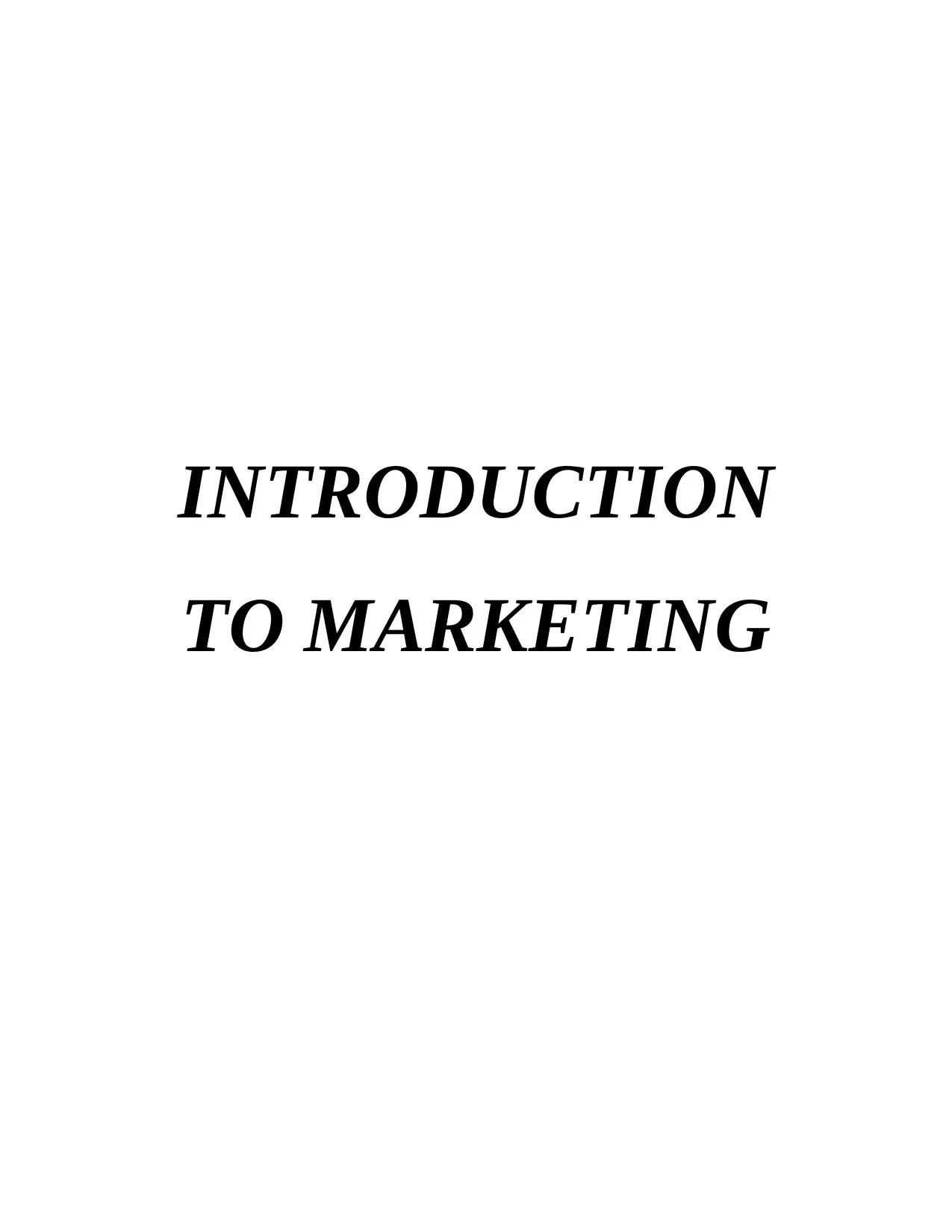
INTRODUCTION
TO MARKETING
TO MARKETING
Paraphrase This Document
Need a fresh take? Get an instant paraphrase of this document with our AI Paraphraser
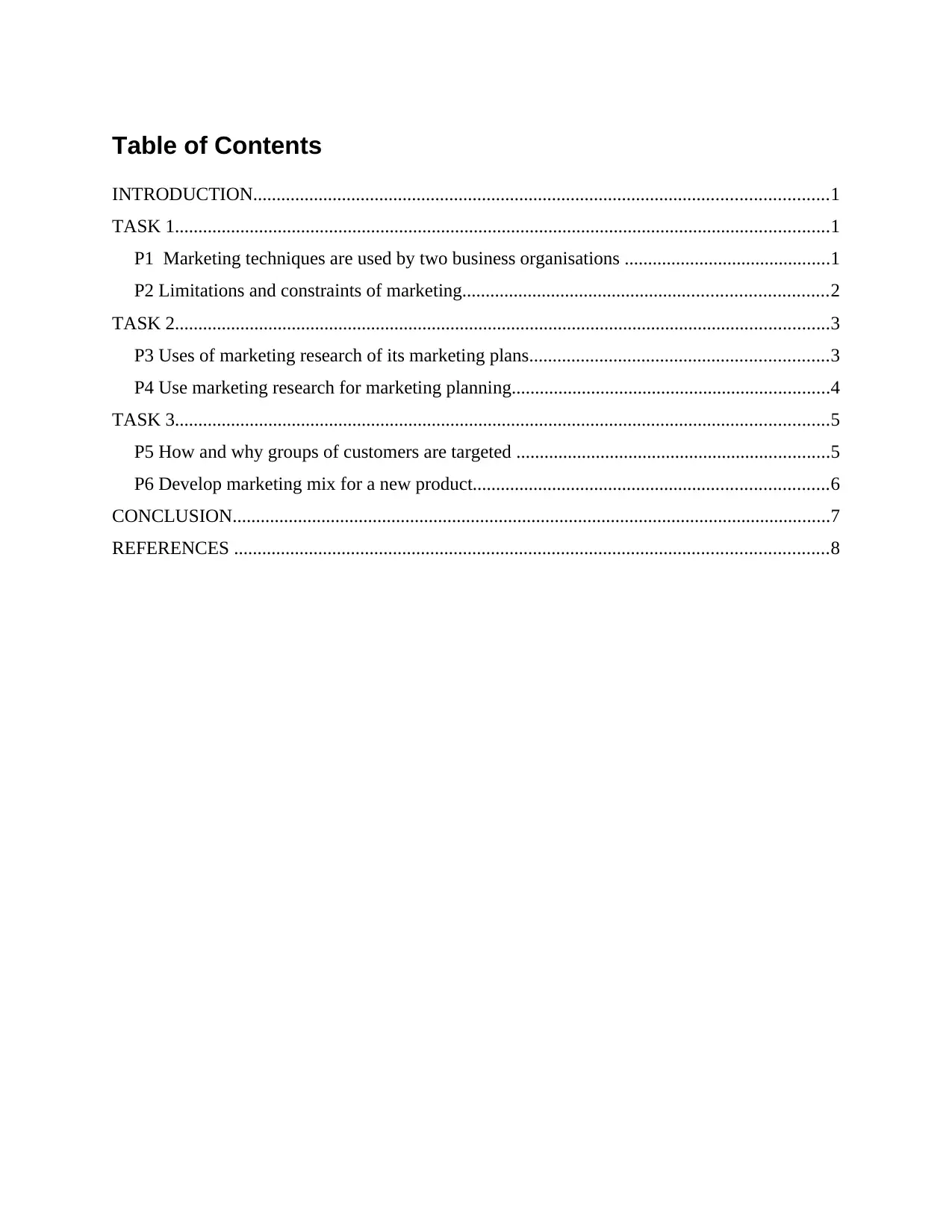
Table of Contents
INTRODUCTION...........................................................................................................................1
TASK 1............................................................................................................................................1
P1 Marketing techniques are used by two business organisations ............................................1
P2 Limitations and constraints of marketing..............................................................................2
TASK 2............................................................................................................................................3
P3 Uses of marketing research of its marketing plans................................................................3
P4 Use marketing research for marketing planning....................................................................4
TASK 3............................................................................................................................................5
P5 How and why groups of customers are targeted ...................................................................5
P6 Develop marketing mix for a new product............................................................................6
CONCLUSION................................................................................................................................7
REFERENCES ...............................................................................................................................8
INTRODUCTION...........................................................................................................................1
TASK 1............................................................................................................................................1
P1 Marketing techniques are used by two business organisations ............................................1
P2 Limitations and constraints of marketing..............................................................................2
TASK 2............................................................................................................................................3
P3 Uses of marketing research of its marketing plans................................................................3
P4 Use marketing research for marketing planning....................................................................4
TASK 3............................................................................................................................................5
P5 How and why groups of customers are targeted ...................................................................5
P6 Develop marketing mix for a new product............................................................................6
CONCLUSION................................................................................................................................7
REFERENCES ...............................................................................................................................8
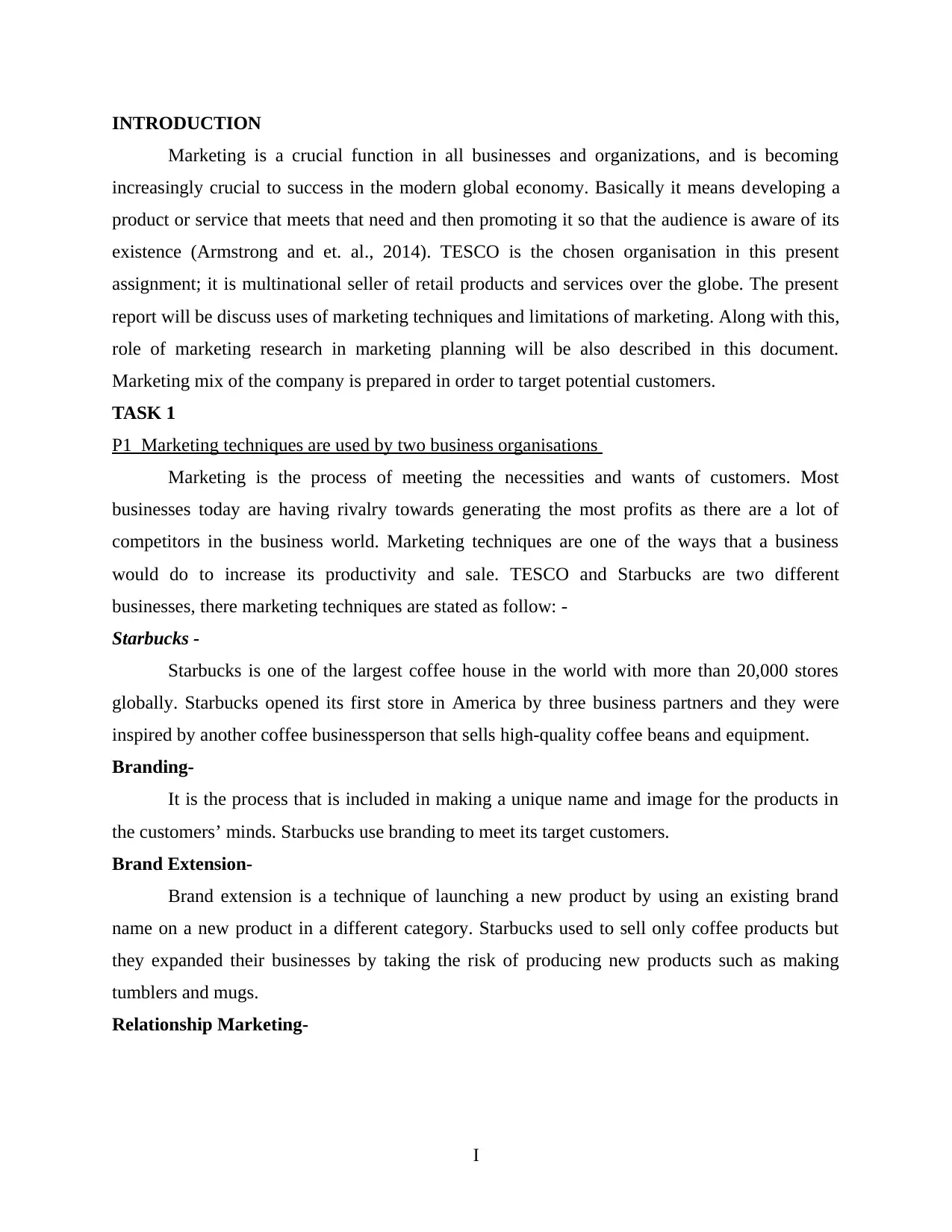
INTRODUCTION
Marketing is a crucial function in all businesses and organizations, and is becoming
increasingly crucial to success in the modern global economy. Basically it means developing a
product or service that meets that need and then promoting it so that the audience is aware of its
existence (Armstrong and et. al., 2014). TESCO is the chosen organisation in this present
assignment; it is multinational seller of retail products and services over the globe. The present
report will be discuss uses of marketing techniques and limitations of marketing. Along with this,
role of marketing research in marketing planning will be also described in this document.
Marketing mix of the company is prepared in order to target potential customers.
TASK 1
P1 Marketing techniques are used by two business organisations
Marketing is the process of meeting the necessities and wants of customers. Most
businesses today are having rivalry towards generating the most profits as there are a lot of
competitors in the business world. Marketing techniques are one of the ways that a business
would do to increase its productivity and sale. TESCO and Starbucks are two different
businesses, there marketing techniques are stated as follow: -
Starbucks -
Starbucks is one of the largest coffee house in the world with more than 20,000 stores
globally. Starbucks opened its first store in America by three business partners and they were
inspired by another coffee businessperson that sells high-quality coffee beans and equipment.
Branding-
It is the process that is included in making a unique name and image for the products in
the customers’ minds. Starbucks use branding to meet its target customers.
Brand Extension-
Brand extension is a technique of launching a new product by using an existing brand
name on a new product in a different category. Starbucks used to sell only coffee products but
they expanded their businesses by taking the risk of producing new products such as making
tumblers and mugs.
Relationship Marketing-
I
Marketing is a crucial function in all businesses and organizations, and is becoming
increasingly crucial to success in the modern global economy. Basically it means developing a
product or service that meets that need and then promoting it so that the audience is aware of its
existence (Armstrong and et. al., 2014). TESCO is the chosen organisation in this present
assignment; it is multinational seller of retail products and services over the globe. The present
report will be discuss uses of marketing techniques and limitations of marketing. Along with this,
role of marketing research in marketing planning will be also described in this document.
Marketing mix of the company is prepared in order to target potential customers.
TASK 1
P1 Marketing techniques are used by two business organisations
Marketing is the process of meeting the necessities and wants of customers. Most
businesses today are having rivalry towards generating the most profits as there are a lot of
competitors in the business world. Marketing techniques are one of the ways that a business
would do to increase its productivity and sale. TESCO and Starbucks are two different
businesses, there marketing techniques are stated as follow: -
Starbucks -
Starbucks is one of the largest coffee house in the world with more than 20,000 stores
globally. Starbucks opened its first store in America by three business partners and they were
inspired by another coffee businessperson that sells high-quality coffee beans and equipment.
Branding-
It is the process that is included in making a unique name and image for the products in
the customers’ minds. Starbucks use branding to meet its target customers.
Brand Extension-
Brand extension is a technique of launching a new product by using an existing brand
name on a new product in a different category. Starbucks used to sell only coffee products but
they expanded their businesses by taking the risk of producing new products such as making
tumblers and mugs.
Relationship Marketing-
I
⊘ This is a preview!⊘
Do you want full access?
Subscribe today to unlock all pages.

Trusted by 1+ million students worldwide
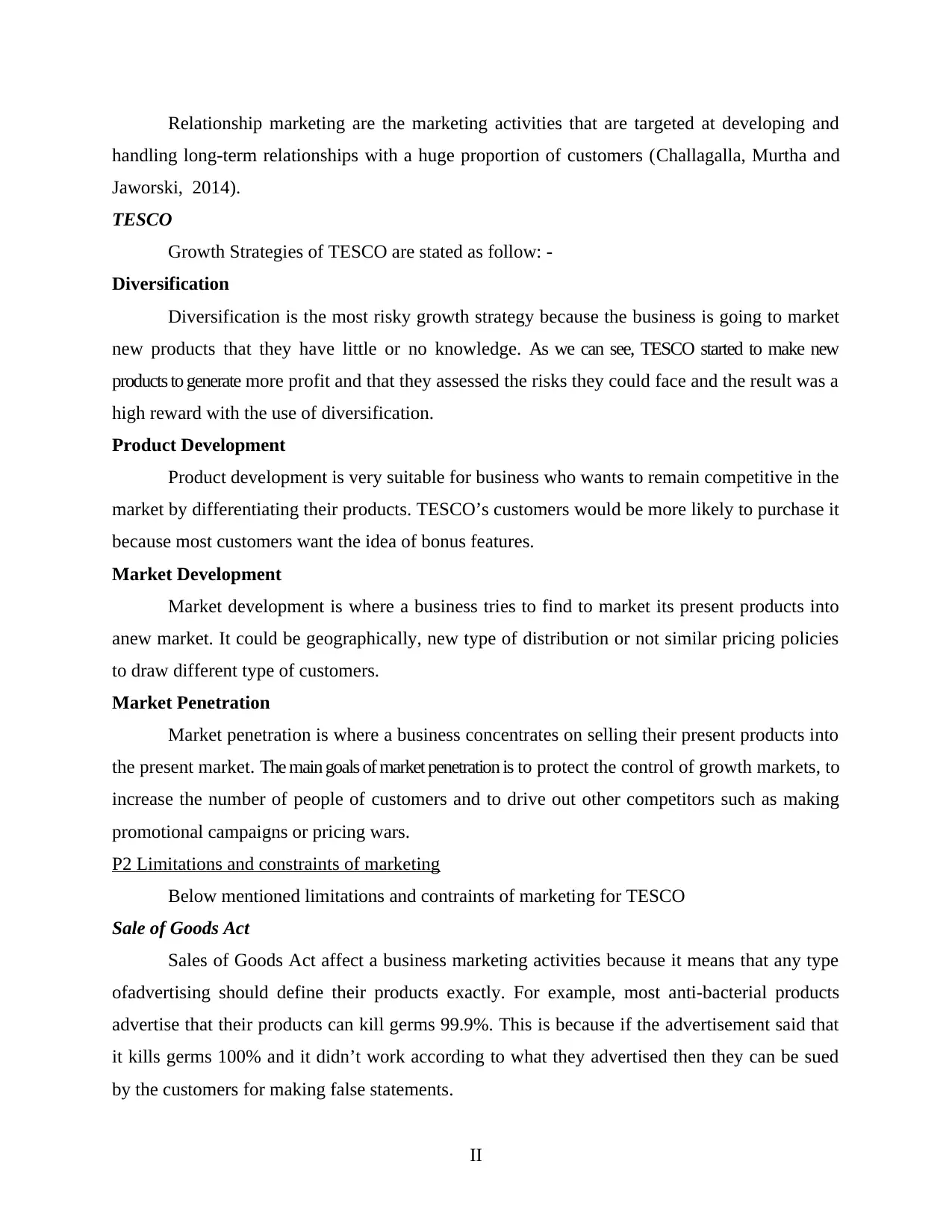
Relationship marketing are the marketing activities that are targeted at developing and
handling long-term relationships with a huge proportion of customers (Challagalla, Murtha and
Jaworski, 2014).
TESCO
Growth Strategies of TESCO are stated as follow: -
Diversification
Diversification is the most risky growth strategy because the business is going to market
new products that they have little or no knowledge. As we can see, TESCO started to make new
products to generate more profit and that they assessed the risks they could face and the result was a
high reward with the use of diversification.
Product Development
Product development is very suitable for business who wants to remain competitive in the
market by differentiating their products. TESCO’s customers would be more likely to purchase it
because most customers want the idea of bonus features.
Market Development
Market development is where a business tries to find to market its present products into
anew market. It could be geographically, new type of distribution or not similar pricing policies
to draw different type of customers.
Market Penetration
Market penetration is where a business concentrates on selling their present products into
the present market. The main goals of market penetration is to protect the control of growth markets, to
increase the number of people of customers and to drive out other competitors such as making
promotional campaigns or pricing wars.
P2 Limitations and constraints of marketing
Below mentioned limitations and contraints of marketing for TESCO
Sale of Goods Act
Sales of Goods Act affect a business marketing activities because it means that any type
ofadvertising should define their products exactly. For example, most anti-bacterial products
advertise that their products can kill germs 99.9%. This is because if the advertisement said that
it kills germs 100% and it didn’t work according to what they advertised then they can be sued
by the customers for making false statements.
II
handling long-term relationships with a huge proportion of customers (Challagalla, Murtha and
Jaworski, 2014).
TESCO
Growth Strategies of TESCO are stated as follow: -
Diversification
Diversification is the most risky growth strategy because the business is going to market
new products that they have little or no knowledge. As we can see, TESCO started to make new
products to generate more profit and that they assessed the risks they could face and the result was a
high reward with the use of diversification.
Product Development
Product development is very suitable for business who wants to remain competitive in the
market by differentiating their products. TESCO’s customers would be more likely to purchase it
because most customers want the idea of bonus features.
Market Development
Market development is where a business tries to find to market its present products into
anew market. It could be geographically, new type of distribution or not similar pricing policies
to draw different type of customers.
Market Penetration
Market penetration is where a business concentrates on selling their present products into
the present market. The main goals of market penetration is to protect the control of growth markets, to
increase the number of people of customers and to drive out other competitors such as making
promotional campaigns or pricing wars.
P2 Limitations and constraints of marketing
Below mentioned limitations and contraints of marketing for TESCO
Sale of Goods Act
Sales of Goods Act affect a business marketing activities because it means that any type
ofadvertising should define their products exactly. For example, most anti-bacterial products
advertise that their products can kill germs 99.9%. This is because if the advertisement said that
it kills germs 100% and it didn’t work according to what they advertised then they can be sued
by the customers for making false statements.
II
Paraphrase This Document
Need a fresh take? Get an instant paraphrase of this document with our AI Paraphraser
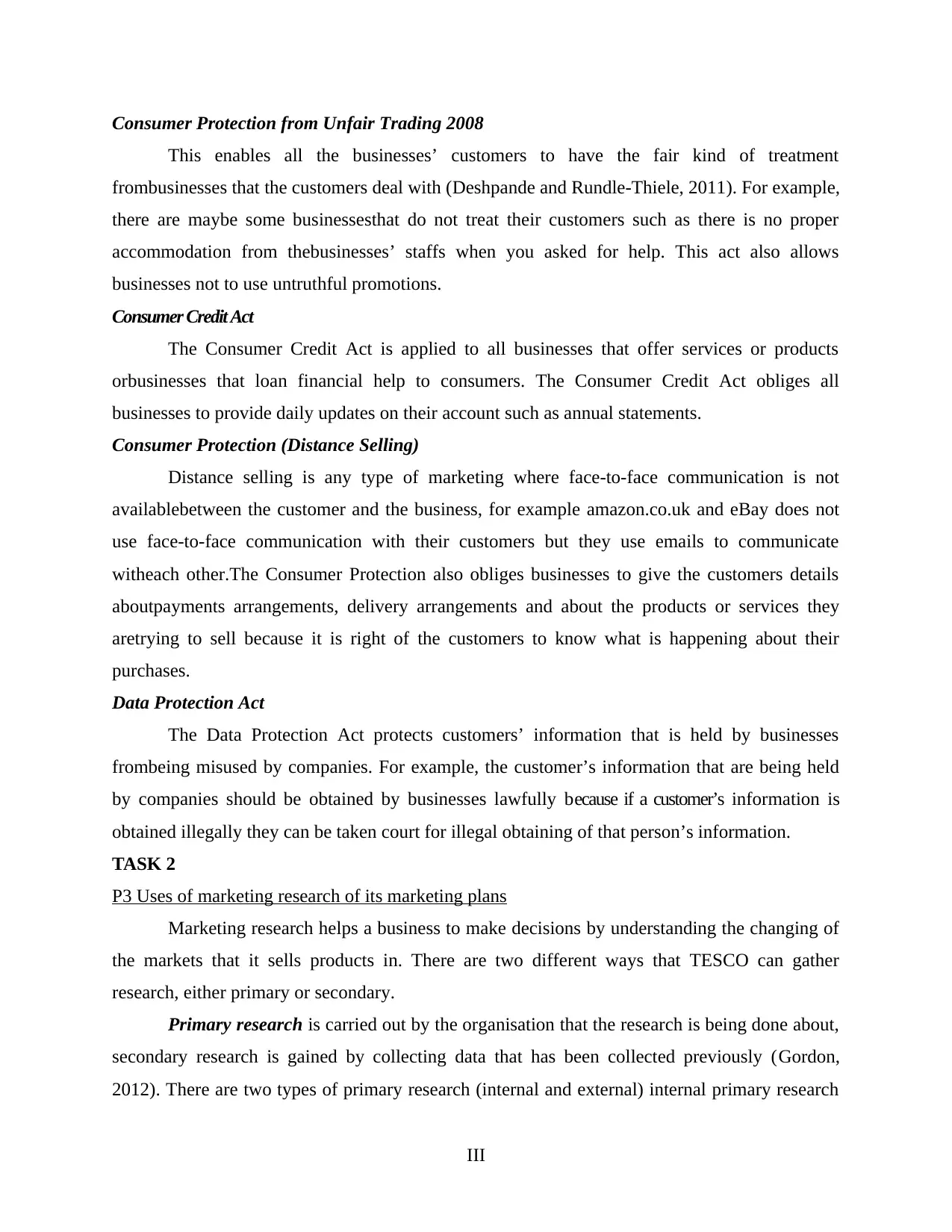
Consumer Protection from Unfair Trading 2008
This enables all the businesses’ customers to have the fair kind of treatment
frombusinesses that the customers deal with (Deshpande and Rundle-Thiele, 2011). For example,
there are maybe some businessesthat do not treat their customers such as there is no proper
accommodation from thebusinesses’ staffs when you asked for help. This act also allows
businesses not to use untruthful promotions.
Consumer Credit Act
The Consumer Credit Act is applied to all businesses that offer services or products
orbusinesses that loan financial help to consumers. The Consumer Credit Act obliges all
businesses to provide daily updates on their account such as annual statements.
Consumer Protection (Distance Selling)
Distance selling is any type of marketing where face-to-face communication is not
availablebetween the customer and the business, for example amazon.co.uk and eBay does not
use face-to-face communication with their customers but they use emails to communicate
witheach other.The Consumer Protection also obliges businesses to give the customers details
aboutpayments arrangements, delivery arrangements and about the products or services they
aretrying to sell because it is right of the customers to know what is happening about their
purchases.
Data Protection Act
The Data Protection Act protects customers’ information that is held by businesses
frombeing misused by companies. For example, the customer’s information that are being held
by companies should be obtained by businesses lawfully because if a customer’s information is
obtained illegally they can be taken court for illegal obtaining of that person’s information.
TASK 2
P3 Uses of marketing research of its marketing plans
Marketing research helps a business to make decisions by understanding the changing of
the markets that it sells products in. There are two different ways that TESCO can gather
research, either primary or secondary.
Primary research is carried out by the organisation that the research is being done about,
secondary research is gained by collecting data that has been collected previously (Gordon,
2012). There are two types of primary research (internal and external) internal primary research
III
This enables all the businesses’ customers to have the fair kind of treatment
frombusinesses that the customers deal with (Deshpande and Rundle-Thiele, 2011). For example,
there are maybe some businessesthat do not treat their customers such as there is no proper
accommodation from thebusinesses’ staffs when you asked for help. This act also allows
businesses not to use untruthful promotions.
Consumer Credit Act
The Consumer Credit Act is applied to all businesses that offer services or products
orbusinesses that loan financial help to consumers. The Consumer Credit Act obliges all
businesses to provide daily updates on their account such as annual statements.
Consumer Protection (Distance Selling)
Distance selling is any type of marketing where face-to-face communication is not
availablebetween the customer and the business, for example amazon.co.uk and eBay does not
use face-to-face communication with their customers but they use emails to communicate
witheach other.The Consumer Protection also obliges businesses to give the customers details
aboutpayments arrangements, delivery arrangements and about the products or services they
aretrying to sell because it is right of the customers to know what is happening about their
purchases.
Data Protection Act
The Data Protection Act protects customers’ information that is held by businesses
frombeing misused by companies. For example, the customer’s information that are being held
by companies should be obtained by businesses lawfully because if a customer’s information is
obtained illegally they can be taken court for illegal obtaining of that person’s information.
TASK 2
P3 Uses of marketing research of its marketing plans
Marketing research helps a business to make decisions by understanding the changing of
the markets that it sells products in. There are two different ways that TESCO can gather
research, either primary or secondary.
Primary research is carried out by the organisation that the research is being done about,
secondary research is gained by collecting data that has been collected previously (Gordon,
2012). There are two types of primary research (internal and external) internal primary research
III
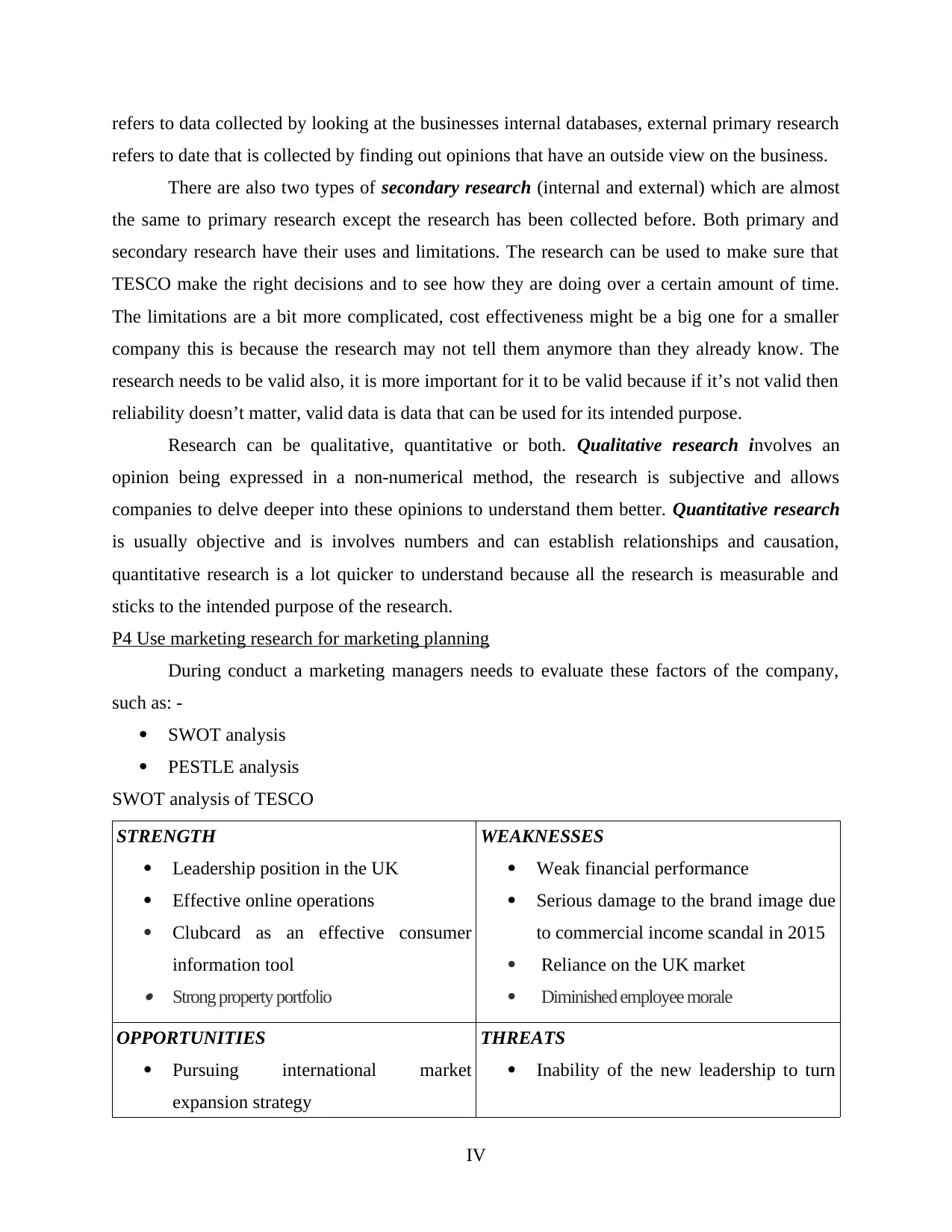
refers to data collected by looking at the businesses internal databases, external primary research
refers to date that is collected by finding out opinions that have an outside view on the business.
There are also two types of secondary research (internal and external) which are almost
the same to primary research except the research has been collected before. Both primary and
secondary research have their uses and limitations. The research can be used to make sure that
TESCO make the right decisions and to see how they are doing over a certain amount of time.
The limitations are a bit more complicated, cost effectiveness might be a big one for a smaller
company this is because the research may not tell them anymore than they already know. The
research needs to be valid also, it is more important for it to be valid because if it’s not valid then
reliability doesn’t matter, valid data is data that can be used for its intended purpose.
Research can be qualitative, quantitative or both. Qualitative research involves an
opinion being expressed in a non-numerical method, the research is subjective and allows
companies to delve deeper into these opinions to understand them better. Quantitative research
is usually objective and is involves numbers and can establish relationships and causation,
quantitative research is a lot quicker to understand because all the research is measurable and
sticks to the intended purpose of the research.
P4 Use marketing research for marketing planning
During conduct a marketing managers needs to evaluate these factors of the company,
such as: -
SWOT analysis
PESTLE analysis
SWOT analysis of TESCO
STRENGTH
Leadership position in the UK
Effective online operations
Clubcard as an effective consumer
information tool Strong property portfolio
WEAKNESSES
Weak financial performance
Serious damage to the brand image due
to commercial income scandal in 2015
Reliance on the UK market
Diminished employee morale
OPPORTUNITIES
Pursuing international market
expansion strategy
THREATS
Inability of the new leadership to turn
IV
refers to date that is collected by finding out opinions that have an outside view on the business.
There are also two types of secondary research (internal and external) which are almost
the same to primary research except the research has been collected before. Both primary and
secondary research have their uses and limitations. The research can be used to make sure that
TESCO make the right decisions and to see how they are doing over a certain amount of time.
The limitations are a bit more complicated, cost effectiveness might be a big one for a smaller
company this is because the research may not tell them anymore than they already know. The
research needs to be valid also, it is more important for it to be valid because if it’s not valid then
reliability doesn’t matter, valid data is data that can be used for its intended purpose.
Research can be qualitative, quantitative or both. Qualitative research involves an
opinion being expressed in a non-numerical method, the research is subjective and allows
companies to delve deeper into these opinions to understand them better. Quantitative research
is usually objective and is involves numbers and can establish relationships and causation,
quantitative research is a lot quicker to understand because all the research is measurable and
sticks to the intended purpose of the research.
P4 Use marketing research for marketing planning
During conduct a marketing managers needs to evaluate these factors of the company,
such as: -
SWOT analysis
PESTLE analysis
SWOT analysis of TESCO
STRENGTH
Leadership position in the UK
Effective online operations
Clubcard as an effective consumer
information tool Strong property portfolio
WEAKNESSES
Weak financial performance
Serious damage to the brand image due
to commercial income scandal in 2015
Reliance on the UK market
Diminished employee morale
OPPORTUNITIES
Pursuing international market
expansion strategy
THREATS
Inability of the new leadership to turn
IV
⊘ This is a preview!⊘
Do you want full access?
Subscribe today to unlock all pages.

Trusted by 1+ million students worldwide
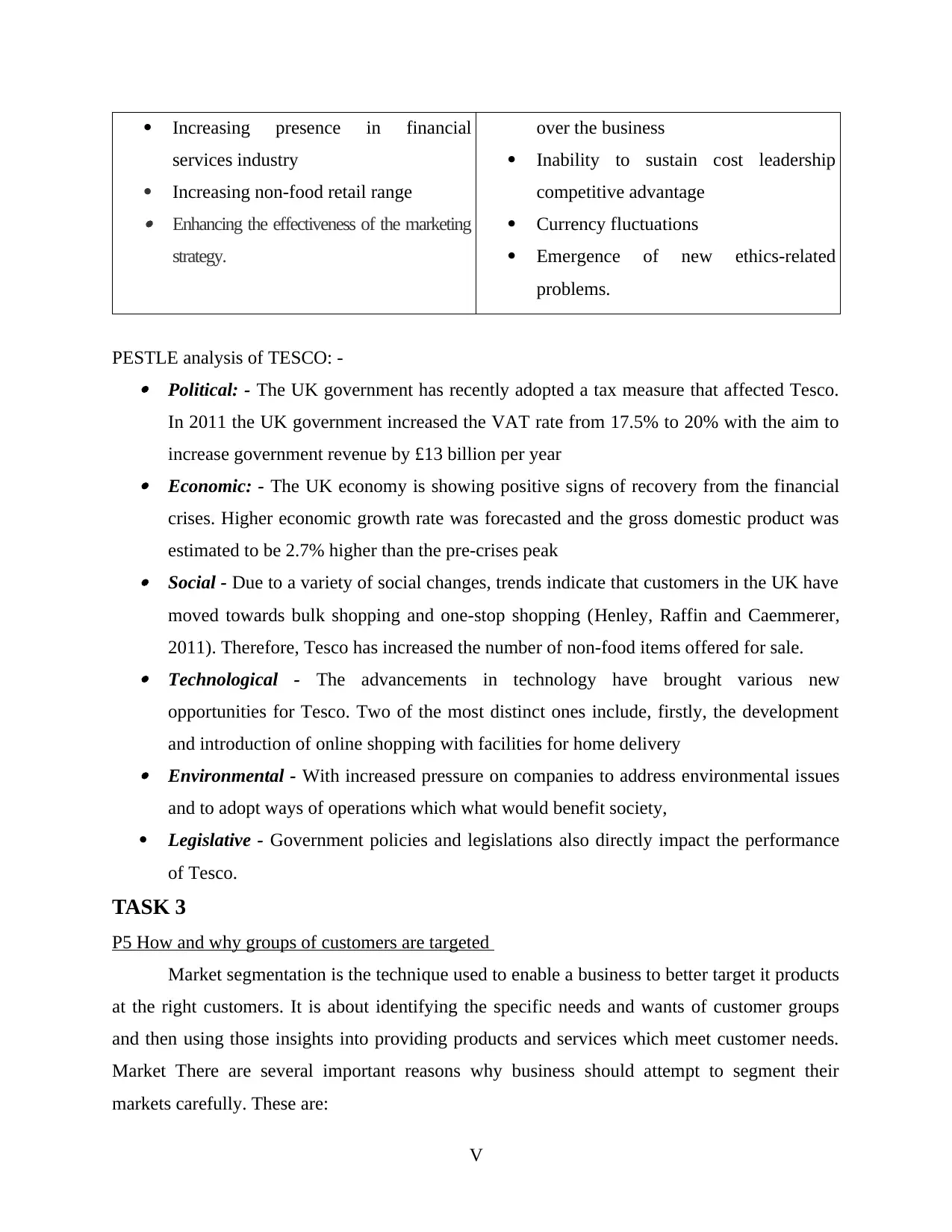
Increasing presence in financial
services industry
Increasing non-food retail range Enhancing the effectiveness of the marketing
strategy.
over the business
Inability to sustain cost leadership
competitive advantage
Currency fluctuations
Emergence of new ethics-related
problems.
PESTLE analysis of TESCO: - Political: - The UK government has recently adopted a tax measure that affected Tesco.
In 2011 the UK government increased the VAT rate from 17.5% to 20% with the aim to
increase government revenue by £13 billion per year Economic: - The UK economy is showing positive signs of recovery from the financial
crises. Higher economic growth rate was forecasted and the gross domestic product was
estimated to be 2.7% higher than the pre-crises peak Social - Due to a variety of social changes, trends indicate that customers in the UK have
moved towards bulk shopping and one-stop shopping (Henley, Raffin and Caemmerer,
2011). Therefore, Tesco has increased the number of non-food items offered for sale. Technological - The advancements in technology have brought various new
opportunities for Tesco. Two of the most distinct ones include, firstly, the development
and introduction of online shopping with facilities for home delivery Environmental - With increased pressure on companies to address environmental issues
and to adopt ways of operations which what would benefit society,
Legislative - Government policies and legislations also directly impact the performance
of Tesco.
TASK 3
P5 How and why groups of customers are targeted
Market segmentation is the technique used to enable a business to better target it products
at the right customers. It is about identifying the specific needs and wants of customer groups
and then using those insights into providing products and services which meet customer needs.
Market There are several important reasons why business should attempt to segment their
markets carefully. These are:
V
services industry
Increasing non-food retail range Enhancing the effectiveness of the marketing
strategy.
over the business
Inability to sustain cost leadership
competitive advantage
Currency fluctuations
Emergence of new ethics-related
problems.
PESTLE analysis of TESCO: - Political: - The UK government has recently adopted a tax measure that affected Tesco.
In 2011 the UK government increased the VAT rate from 17.5% to 20% with the aim to
increase government revenue by £13 billion per year Economic: - The UK economy is showing positive signs of recovery from the financial
crises. Higher economic growth rate was forecasted and the gross domestic product was
estimated to be 2.7% higher than the pre-crises peak Social - Due to a variety of social changes, trends indicate that customers in the UK have
moved towards bulk shopping and one-stop shopping (Henley, Raffin and Caemmerer,
2011). Therefore, Tesco has increased the number of non-food items offered for sale. Technological - The advancements in technology have brought various new
opportunities for Tesco. Two of the most distinct ones include, firstly, the development
and introduction of online shopping with facilities for home delivery Environmental - With increased pressure on companies to address environmental issues
and to adopt ways of operations which what would benefit society,
Legislative - Government policies and legislations also directly impact the performance
of Tesco.
TASK 3
P5 How and why groups of customers are targeted
Market segmentation is the technique used to enable a business to better target it products
at the right customers. It is about identifying the specific needs and wants of customer groups
and then using those insights into providing products and services which meet customer needs.
Market There are several important reasons why business should attempt to segment their
markets carefully. These are:
V
Paraphrase This Document
Need a fresh take? Get an instant paraphrase of this document with our AI Paraphraser
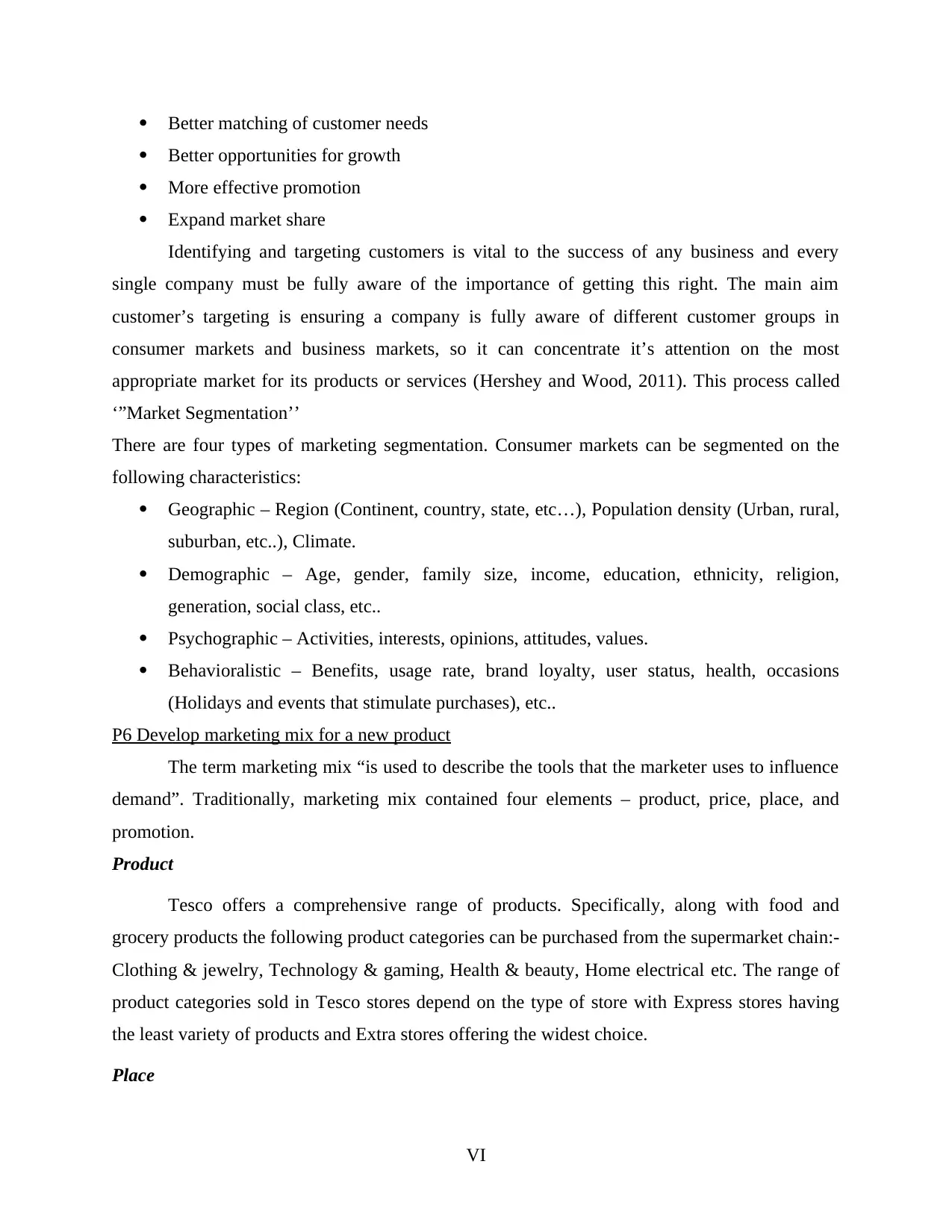
Better matching of customer needs
Better opportunities for growth
More effective promotion
Expand market share
Identifying and targeting customers is vital to the success of any business and every
single company must be fully aware of the importance of getting this right. The main aim
customer’s targeting is ensuring a company is fully aware of different customer groups in
consumer markets and business markets, so it can concentrate it’s attention on the most
appropriate market for its products or services (Hershey and Wood, 2011). This process called
‘”Market Segmentation’’
There are four types of marketing segmentation. Consumer markets can be segmented on the
following characteristics:
Geographic – Region (Continent, country, state, etc…), Population density (Urban, rural,
suburban, etc..), Climate.
Demographic – Age, gender, family size, income, education, ethnicity, religion,
generation, social class, etc..
Psychographic – Activities, interests, opinions, attitudes, values.
Behavioralistic – Benefits, usage rate, brand loyalty, user status, health, occasions
(Holidays and events that stimulate purchases), etc..
P6 Develop marketing mix for a new product
The term marketing mix “is used to describe the tools that the marketer uses to influence
demand”. Traditionally, marketing mix contained four elements – product, price, place, and
promotion.
Product
Tesco offers a comprehensive range of products. Specifically, along with food and
grocery products the following product categories can be purchased from the supermarket chain:-
Clothing & jewelry, Technology & gaming, Health & beauty, Home electrical etc. The range of
product categories sold in Tesco stores depend on the type of store with Express stores having
the least variety of products and Extra stores offering the widest choice.
Place
VI
Better opportunities for growth
More effective promotion
Expand market share
Identifying and targeting customers is vital to the success of any business and every
single company must be fully aware of the importance of getting this right. The main aim
customer’s targeting is ensuring a company is fully aware of different customer groups in
consumer markets and business markets, so it can concentrate it’s attention on the most
appropriate market for its products or services (Hershey and Wood, 2011). This process called
‘”Market Segmentation’’
There are four types of marketing segmentation. Consumer markets can be segmented on the
following characteristics:
Geographic – Region (Continent, country, state, etc…), Population density (Urban, rural,
suburban, etc..), Climate.
Demographic – Age, gender, family size, income, education, ethnicity, religion,
generation, social class, etc..
Psychographic – Activities, interests, opinions, attitudes, values.
Behavioralistic – Benefits, usage rate, brand loyalty, user status, health, occasions
(Holidays and events that stimulate purchases), etc..
P6 Develop marketing mix for a new product
The term marketing mix “is used to describe the tools that the marketer uses to influence
demand”. Traditionally, marketing mix contained four elements – product, price, place, and
promotion.
Product
Tesco offers a comprehensive range of products. Specifically, along with food and
grocery products the following product categories can be purchased from the supermarket chain:-
Clothing & jewelry, Technology & gaming, Health & beauty, Home electrical etc. The range of
product categories sold in Tesco stores depend on the type of store with Express stores having
the least variety of products and Extra stores offering the widest choice.
Place
VI
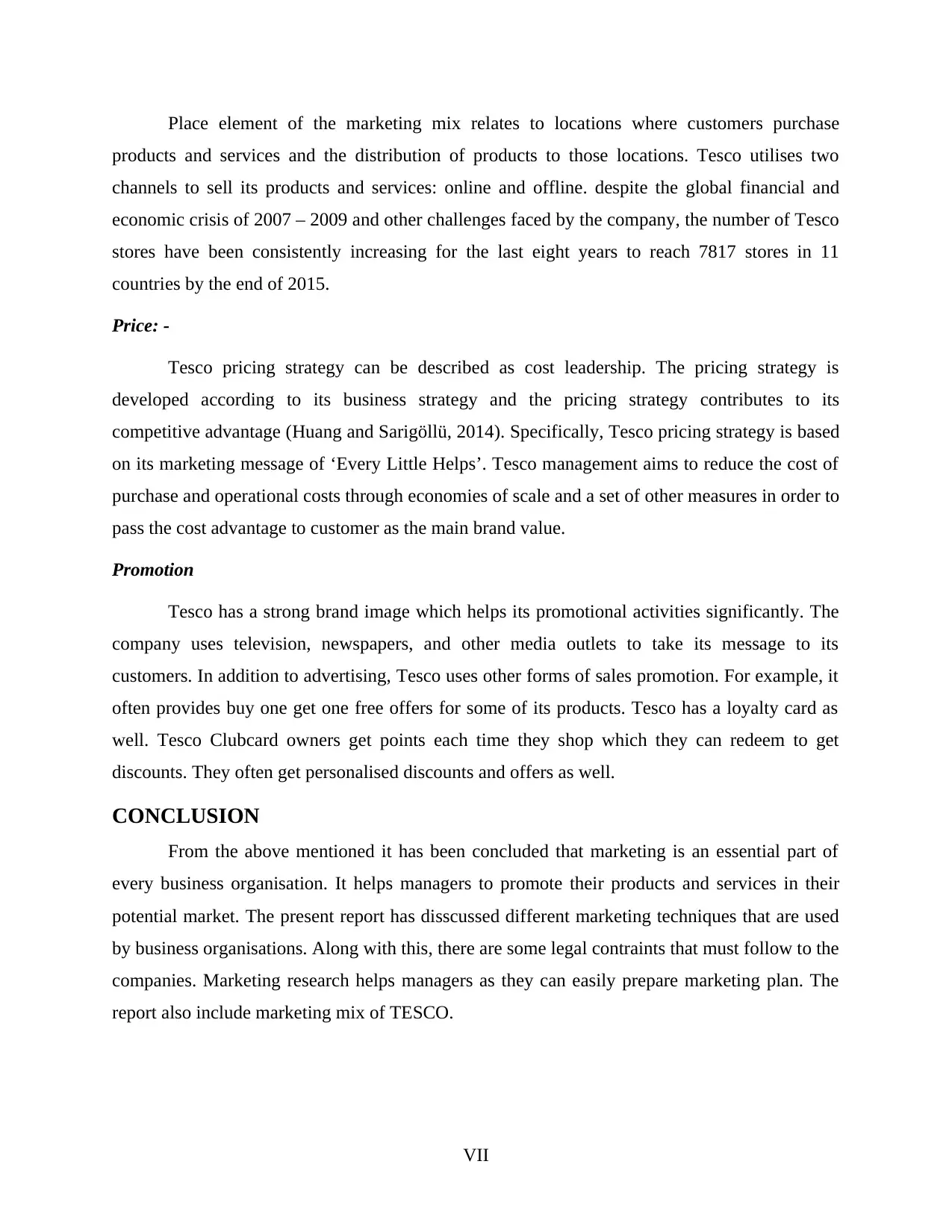
Place element of the marketing mix relates to locations where customers purchase
products and services and the distribution of products to those locations. Tesco utilises two
channels to sell its products and services: online and offline. despite the global financial and
economic crisis of 2007 – 2009 and other challenges faced by the company, the number of Tesco
stores have been consistently increasing for the last eight years to reach 7817 stores in 11
countries by the end of 2015.
Price: -
Tesco pricing strategy can be described as cost leadership. The pricing strategy is
developed according to its business strategy and the pricing strategy contributes to its
competitive advantage (Huang and Sarigöllü, 2014). Specifically, Tesco pricing strategy is based
on its marketing message of ‘Every Little Helps’. Tesco management aims to reduce the cost of
purchase and operational costs through economies of scale and a set of other measures in order to
pass the cost advantage to customer as the main brand value.
Promotion
Tesco has a strong brand image which helps its promotional activities significantly. The
company uses television, newspapers, and other media outlets to take its message to its
customers. In addition to advertising, Tesco uses other forms of sales promotion. For example, it
often provides buy one get one free offers for some of its products. Tesco has a loyalty card as
well. Tesco Clubcard owners get points each time they shop which they can redeem to get
discounts. They often get personalised discounts and offers as well.
CONCLUSION
From the above mentioned it has been concluded that marketing is an essential part of
every business organisation. It helps managers to promote their products and services in their
potential market. The present report has disscussed different marketing techniques that are used
by business organisations. Along with this, there are some legal contraints that must follow to the
companies. Marketing research helps managers as they can easily prepare marketing plan. The
report also include marketing mix of TESCO.
VII
products and services and the distribution of products to those locations. Tesco utilises two
channels to sell its products and services: online and offline. despite the global financial and
economic crisis of 2007 – 2009 and other challenges faced by the company, the number of Tesco
stores have been consistently increasing for the last eight years to reach 7817 stores in 11
countries by the end of 2015.
Price: -
Tesco pricing strategy can be described as cost leadership. The pricing strategy is
developed according to its business strategy and the pricing strategy contributes to its
competitive advantage (Huang and Sarigöllü, 2014). Specifically, Tesco pricing strategy is based
on its marketing message of ‘Every Little Helps’. Tesco management aims to reduce the cost of
purchase and operational costs through economies of scale and a set of other measures in order to
pass the cost advantage to customer as the main brand value.
Promotion
Tesco has a strong brand image which helps its promotional activities significantly. The
company uses television, newspapers, and other media outlets to take its message to its
customers. In addition to advertising, Tesco uses other forms of sales promotion. For example, it
often provides buy one get one free offers for some of its products. Tesco has a loyalty card as
well. Tesco Clubcard owners get points each time they shop which they can redeem to get
discounts. They often get personalised discounts and offers as well.
CONCLUSION
From the above mentioned it has been concluded that marketing is an essential part of
every business organisation. It helps managers to promote their products and services in their
potential market. The present report has disscussed different marketing techniques that are used
by business organisations. Along with this, there are some legal contraints that must follow to the
companies. Marketing research helps managers as they can easily prepare marketing plan. The
report also include marketing mix of TESCO.
VII
⊘ This is a preview!⊘
Do you want full access?
Subscribe today to unlock all pages.

Trusted by 1+ million students worldwide
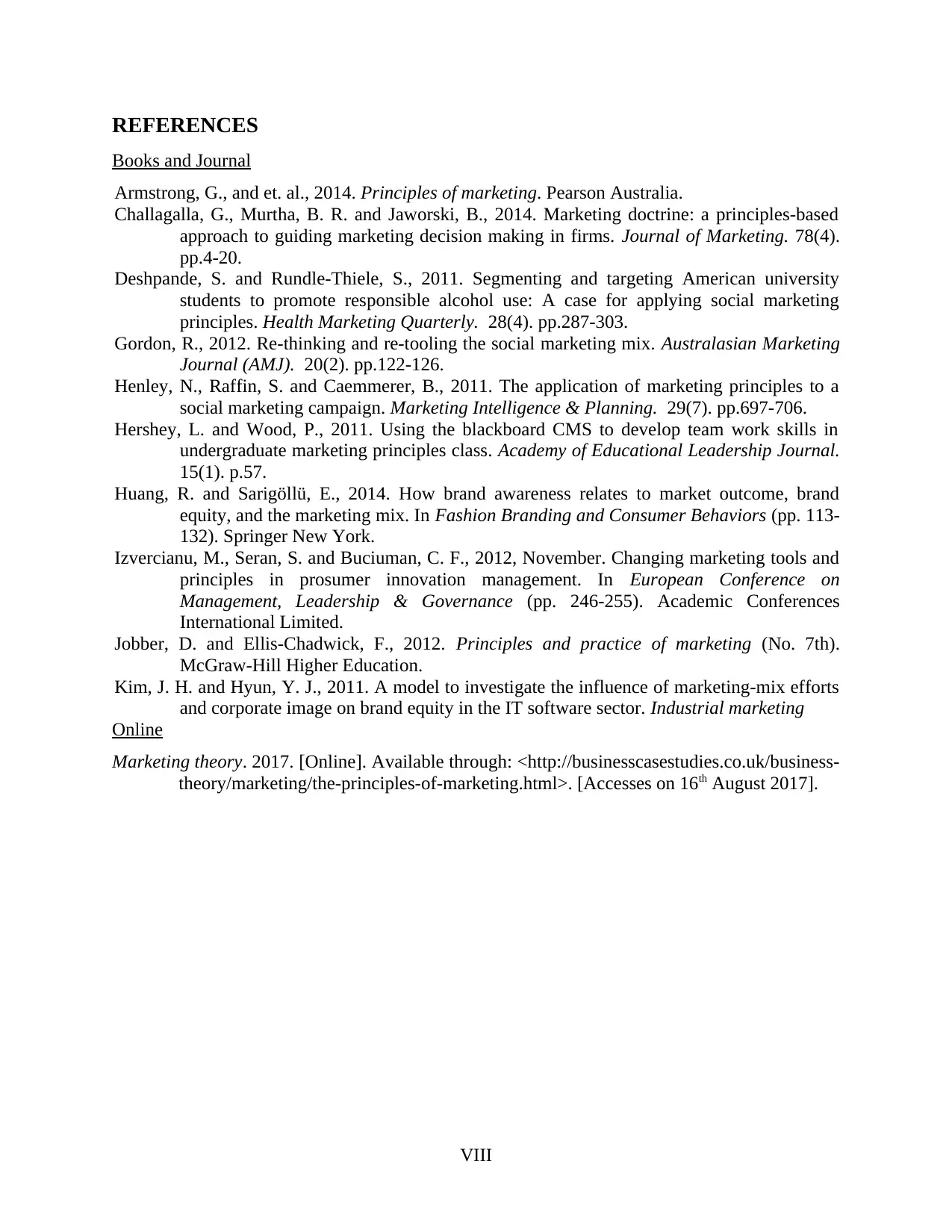
REFERENCES
Books and Journal
Armstrong, G., and et. al., 2014. Principles of marketing. Pearson Australia.
Challagalla, G., Murtha, B. R. and Jaworski, B., 2014. Marketing doctrine: a principles-based
approach to guiding marketing decision making in firms. Journal of Marketing. 78(4).
pp.4-20.
Deshpande, S. and Rundle-Thiele, S., 2011. Segmenting and targeting American university
students to promote responsible alcohol use: A case for applying social marketing
principles. Health Marketing Quarterly. 28(4). pp.287-303.
Gordon, R., 2012. Re-thinking and re-tooling the social marketing mix. Australasian Marketing
Journal (AMJ). 20(2). pp.122-126.
Henley, N., Raffin, S. and Caemmerer, B., 2011. The application of marketing principles to a
social marketing campaign. Marketing Intelligence & Planning. 29(7). pp.697-706.
Hershey, L. and Wood, P., 2011. Using the blackboard CMS to develop team work skills in
undergraduate marketing principles class. Academy of Educational Leadership Journal.
15(1). p.57.
Huang, R. and Sarigöllü, E., 2014. How brand awareness relates to market outcome, brand
equity, and the marketing mix. In Fashion Branding and Consumer Behaviors (pp. 113-
132). Springer New York.
Izvercianu, M., Seran, S. and Buciuman, C. F., 2012, November. Changing marketing tools and
principles in prosumer innovation management. In European Conference on
Management, Leadership & Governance (pp. 246-255). Academic Conferences
International Limited.
Jobber, D. and Ellis-Chadwick, F., 2012. Principles and practice of marketing (No. 7th).
McGraw-Hill Higher Education.
Kim, J. H. and Hyun, Y. J., 2011. A model to investigate the influence of marketing-mix efforts
and corporate image on brand equity in the IT software sector. Industrial marketing
Online
Marketing theory. 2017. [Online]. Available through: <http://businesscasestudies.co.uk/business-
theory/marketing/the-principles-of-marketing.html>. [Accesses on 16th August 2017].
VIII
Books and Journal
Armstrong, G., and et. al., 2014. Principles of marketing. Pearson Australia.
Challagalla, G., Murtha, B. R. and Jaworski, B., 2014. Marketing doctrine: a principles-based
approach to guiding marketing decision making in firms. Journal of Marketing. 78(4).
pp.4-20.
Deshpande, S. and Rundle-Thiele, S., 2011. Segmenting and targeting American university
students to promote responsible alcohol use: A case for applying social marketing
principles. Health Marketing Quarterly. 28(4). pp.287-303.
Gordon, R., 2012. Re-thinking and re-tooling the social marketing mix. Australasian Marketing
Journal (AMJ). 20(2). pp.122-126.
Henley, N., Raffin, S. and Caemmerer, B., 2011. The application of marketing principles to a
social marketing campaign. Marketing Intelligence & Planning. 29(7). pp.697-706.
Hershey, L. and Wood, P., 2011. Using the blackboard CMS to develop team work skills in
undergraduate marketing principles class. Academy of Educational Leadership Journal.
15(1). p.57.
Huang, R. and Sarigöllü, E., 2014. How brand awareness relates to market outcome, brand
equity, and the marketing mix. In Fashion Branding and Consumer Behaviors (pp. 113-
132). Springer New York.
Izvercianu, M., Seran, S. and Buciuman, C. F., 2012, November. Changing marketing tools and
principles in prosumer innovation management. In European Conference on
Management, Leadership & Governance (pp. 246-255). Academic Conferences
International Limited.
Jobber, D. and Ellis-Chadwick, F., 2012. Principles and practice of marketing (No. 7th).
McGraw-Hill Higher Education.
Kim, J. H. and Hyun, Y. J., 2011. A model to investigate the influence of marketing-mix efforts
and corporate image on brand equity in the IT software sector. Industrial marketing
Online
Marketing theory. 2017. [Online]. Available through: <http://businesscasestudies.co.uk/business-
theory/marketing/the-principles-of-marketing.html>. [Accesses on 16th August 2017].
VIII
1 out of 10
Related Documents
Your All-in-One AI-Powered Toolkit for Academic Success.
+13062052269
info@desklib.com
Available 24*7 on WhatsApp / Email
![[object Object]](/_next/static/media/star-bottom.7253800d.svg)
Unlock your academic potential
Copyright © 2020–2025 A2Z Services. All Rights Reserved. Developed and managed by ZUCOL.





